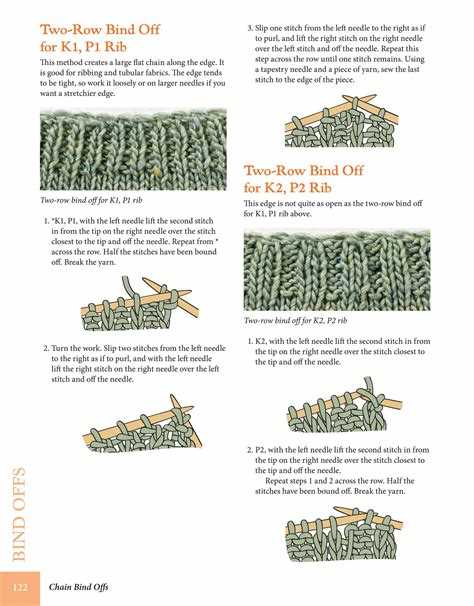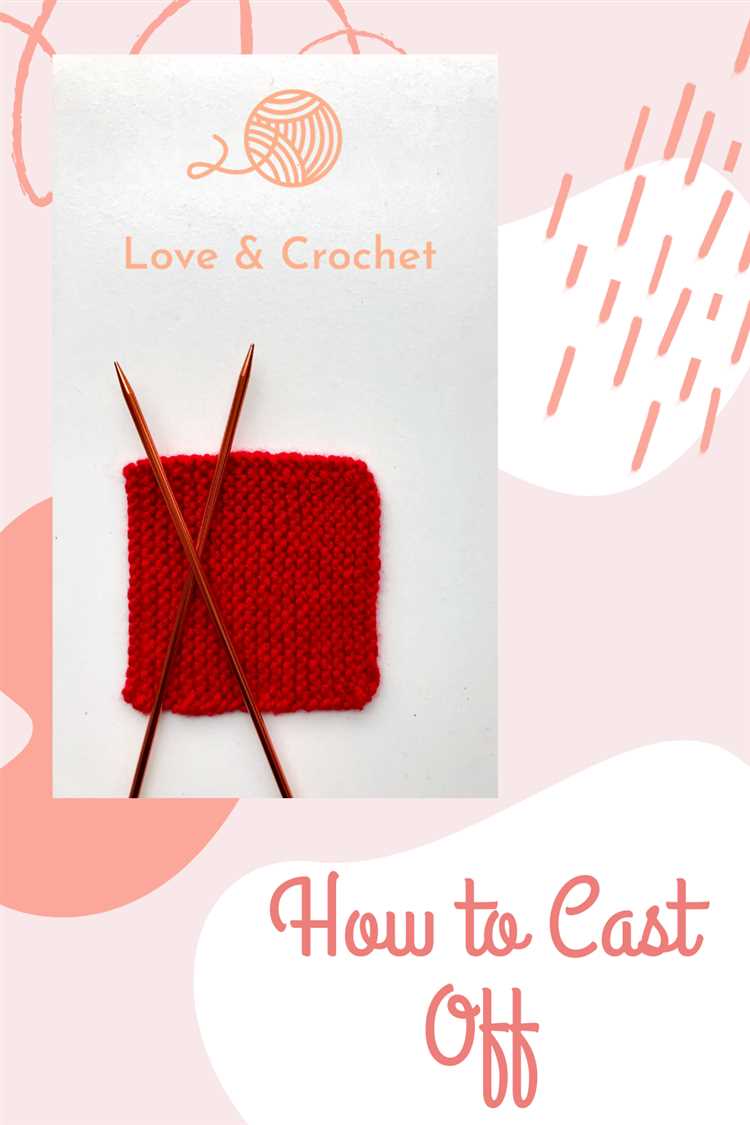Knitting is a relaxing and creative hobby that has been passed down through generations. Whether you’re a beginner or an experienced knitter, learning how to cast off is an essential skill to complete your knitting project. Casting off, also known as binding off, is the process of removing your stitches from the knitting needle, securing them in place, and finishing the edge of your project.
While casting off may seem daunting at first, it’s a simple technique that you’ll quickly master with a little practice. In this step-by-step guide, we’ll walk you through the process of casting off, providing clear instructions and helpful tips along the way. By the end, you’ll have the confidence to cast off your knitting projects with ease, giving them a professional and polished look.
Before we begin, it’s important to note that different knitting projects may require different casting off techniques. In this guide, we’ll focus on the basic method that works for most projects. If you’re working on a specific pattern or stitch, make sure to read the instructions carefully to determine the appropriate casting off technique.
Are you ready to learn how to cast off your knitting? Let’s get started with step one: preparing your knitting for casting off.
Understanding the Basics of Casting Off
Once you have finished knitting your project, the next step is to cast off or bind off your stitches. This is the process of securing the stitches so that they do not unravel. Casting off is an essential skill in knitting and is often used to finish the edges of a project, create a neat hem, or complete the final row.
Here are the basic steps to cast off:
- Knit the first two stitches as you normally would.
- Take the left needle and insert it into the first stitch on the right needle.
- Bring the yarn over the right needle from back to front and knit the first stitch using the back leg of the stitch.
- Knit the next stitch as usual.
- Using the left needle, lift the first stitch over the second stitch and completely off the right needle.
- Continue knitting the next stitch and lifting the previous stitch over until only one stitch remains on the right needle.
- Cut the yarn, leaving a long tail.
- Pull the tail through the remaining stitch to secure it.
It’s important to maintain an even tension while casting off to ensure that the edge of your project is not too tight or loose. You can practice casting off on a small swatch before attempting it on your actual project.
Tips for successful casting off:
- Avoid casting off too tightly, as this can make it difficult to weave in the ends.
- Make sure to leave a long enough tail to weave in later without running out of yarn.
- Take your time and work at a comfortable pace to ensure accuracy.
- If you make a mistake, simply unravel the last stitch and try again.
With practice, casting off will become second nature and you’ll be able to complete your knitting projects with confidence.
Choosing the Right Yarn and Needles
When learning how to cast off knitting, it is important to choose the right yarn and needles for your project. Here are some tips to consider:
- Yarn Weight: The weight of the yarn you choose will determine the thickness and warmth of your finished project. Choose a yarn weight that is appropriate for the type of item you are knitting.
- Needle Size: The size of your needles will also affect the outcome of your project. Use the needle size recommended on the yarn label for best results. However, if you want a looser or tighter fabric, you can opt for a larger or smaller needle size.
- Fiber Content: Consider the fiber content of the yarn you choose. Some fibers, like wool, provide warmth and elasticity, while others, like cotton, are cooler and less stretchy. Choose a fiber that suits the purpose of your project.
- Color and Texture: Have fun with your yarn choice! Consider the color and texture of the yarn to enhance the overall look of your project. Experiment with different combinations to achieve the desired effect.
Once you have chosen the right yarn and needles for your project, you are ready to learn how to cast off knitting. Follow the step-by-step guide to achieve a clean and professional finish to your knitted item.
Creating a Slip Knot
A slip knot is the first step in casting on your knitting project. It allows you to easily start your work and provides a secure loop to begin knitting stitches. Follow the steps below to create a slip knot:
- Start by holding the working yarn in your left hand, leaving a tail of about 6-8 inches.
- Create a loop by crossing the working end of the yarn over the tail end, forming a pretzel shape.
- Take the working end of the yarn and insert it through the loop from behind.
- Gently tighten the loop by pulling on the working end of the yarn, ensuring that the loop is snug but not too tight.
- Place the slip knot onto your knitting needle, pulling the tail end to tighten the loop around the needle.
Once you have created the slip knot and placed it on your knitting needle, you are ready to begin casting on your stitches. The slip knot will act as the first stitch on your needle and provide a foundation for your knitting project.
| Step | Description |
|---|---|
| 1 | Hold the working yarn in your left hand, leaving a tail of about 6-8 inches. |
| 2 | Cross the working end of the yarn over the tail end, forming a pretzel shape. |
| 3 | Insert the working end of the yarn through the loop from behind. |
| 4 | Tighten the loop by pulling on the working end of the yarn. |
| 5 | Place the slip knot onto your knitting needle. |
Starting the Casting Off Process
Once you have completed your knitting project and are ready to finish it off, it’s time to start the casting off process. Casting off, also known as binding off, is the final step in knitting where you secure the stitches so that they don’t unravel.
To start casting off, follow these steps:
- Knit two stitches.
- Insert the left needle into the first stitch you knitted.
- Lift the first stitch over the second stitch and off the right needle. This is known as passing the stitch over.
- Now you have one stitch on the right needle.
- Knit another stitch.
- Repeat steps 2-5 until you reach the end of your row.
Alternatively, you can use the purl stitch instead of the knit stitch if you prefer.
Once you have cast off all of your stitches, you can cut your yarn, leaving a long tail. Thread the tail through the last loop to secure it and pull tight.
Now your knitting project is officially finished!
Knitting the First Stitch
The first stitch in knitting is known as the cast on stitch, and it is the foundation for your knitting project. Once you have successfully cast on your stitches, you are ready to begin knitting your first row.
To knit the first stitch, follow these steps:
- Hold the needle with the cast on stitches in your right hand, with the working yarn coming off the back of the stitch nearest to your hand.
- Insert the right needle into the first stitch on the left needle, from left to right.
- With your right hand, bring the working yarn over the right needle, crossing it with the left needle.
- Use the right needle to pull the working yarn through the first stitch on the left needle, creating a new stitch on the right needle.
- Slide the new stitch off the left needle and onto the right needle.
- Repeat steps 2-5 for each stitch until all the stitches have been transferred from the left needle to the right needle.
Once you have completed knitting the first stitch, you can proceed to knit the rest of the row using the same technique. Remember to always keep the working yarn behind the needles, and to pull the new stitches through the old stitches to create the next row.
Continuing the Casting Off Process
Once you have completed the initial steps of the casting off process, you can continue to remove the stitches from your knitting needles. Follow these steps to complete the casting off process:
- Insert the right needle into the first two stitches on the left needle, from left to right.
- Using the right needle, lift the first stitch you knitted over the second stitch and off the left needle.
- Continue this process, knitting one stitch and lifting the previous stitch over, until there is only one stitch remaining on the right needle.
- When only one stitch remains, cut the yarn, leaving a tail that is a few inches long.
- Thread the yarn tail through the last stitch and gently pull to secure it.
By following these steps, you have successfully completed the casting off process. Your knitting project is now finished and ready to be used or displayed. Congratulations on completing your knitting project!
Remember to practice this casting off technique on smaller projects before attempting it on larger or more complex knits. With practice, you will become more confident and proficient in the casting off process, allowing you to confidently finish any knitting project.
Finishing the Casting Off Process
Once you have completed all of the necessary stitches and are ready to finish casting off, follow these steps:
- Hold the working needle and the free needle. With your right hand, hold the working needle (the one with the stitches) and with your left hand, hold the free needle.
- Move the last stitch to the free needle. Insert the free needle from left to right into the first stitch on the working needle, and slide the stitch off the working needle and onto the free needle.
- Knit the next stitch. Insert the right-hand needle from left to right into the next stitch on the working needle, and wrap the working yarn around the right-hand needle counterclockwise.
- Pass the previous stitch over. Using the left-hand needle, lift the first stitch on the right-hand needle over the second stitch and off the needle. This tightens the stitch and creates a neat edge.
- Repeat steps 3 and 4. Continue knitting the next stitch on the working needle and passing the previous stitch over until only one stitch remains on the right-hand needle.
- Cut the yarn and pull it through the final stitch. Cut the working yarn, leaving a tail that is long enough to weave in later. Pull the tail through the last stitch and tug gently to secure it.
Once you have finished casting off, you can remove the knitting from the needles and admire your finished piece. Remember to weave in any loose ends and give your knitted item a gentle blocking if needed.
Final Tips and Tricks for Casting Off Successfully
Once you have mastered the basic technique of casting off knitting, here are some final tips and tricks to ensure a successful finish for your project:
- Keep your tension consistent: Maintaining an even tension throughout the casting off process is crucial to achieving a neat and professional-looking edge. Avoid pulling the yarn too tightly or leaving it too loose as you work.
- Use a larger needle: When casting off, consider using a needle that is one or two sizes larger than the one you used for knitting your project. This can help prevent the edge from becoming too tight and ensure a more relaxed and stretchy finish.
- Practice makes perfect: Casting off may feel a bit tricky at first, but like any skill, it becomes easier with practice. Don’t get discouraged if your first attempts don’t come out as well as you hope. Keep practicing, and soon you’ll be casting off like a pro.
- Count your stitches: Before beginning the casting off process, count your stitches to ensure you have the correct number. This can help prevent mistakes and ensure that your finished edge is symmetrical and even.
- Try different methods: There are various techniques for casting off, each with its own look and purpose. Experiment with different methods to find the one that works best for your project and gives you the desired finish.
- Leave a long enough tail: When cutting the yarn at the end of your casting off, make sure to leave a long enough tail to weave in later. Having a sufficient amount of yarn will make it easier to secure the loose end and prevent it from unraveling.
By following these tips and tricks, you’ll be able to cast off knitting projects with confidence and achieve professional-looking results. Happy knitting!
FAQ:
What does it mean to “cast off” in knitting?
Casting off in knitting is the process of finishing a knitted piece by creating a neat and secure edge. It involves removing the stitches from the knitting needle, one by one, and binding them off to prevent them from unraveling.
Why is casting off important in knitting?
Casting off is important in knitting because it creates a finished edge that prevents the stitches from unraveling. It also gives the knitted piece a neat and polished look.
Can you cast off knitting mid-row?
Yes, you can cast off knitting mid-row. To do this, you would work until the desired number of stitches remain on the left needle, then cast off those stitches.
What is the most common method for casting off in knitting?
The most common method for casting off in knitting is the basic bind off method. This involves knitting two stitches, then passing the first stitch over the second stitch and off the needle. The process is repeated until all stitches have been bound off.
Are there different techniques for casting off in knitting?
Yes, there are different techniques for casting off in knitting. Some other popular techniques include the stretchy bind off for garments that need extra flexibility, the picot bind off for a decorative edge, and the tubular bind off for a seamless and elastic finish.
Can you cast off knitting without a crochet hook?
Yes, you can cast off knitting without a crochet hook. To do this, you would use the knitting needles to transfer stitches from one needle to the other, following the binding off process. A crochet hook is not necessary for casting off, but it can be helpful for certain techniques or if you prefer using one.


